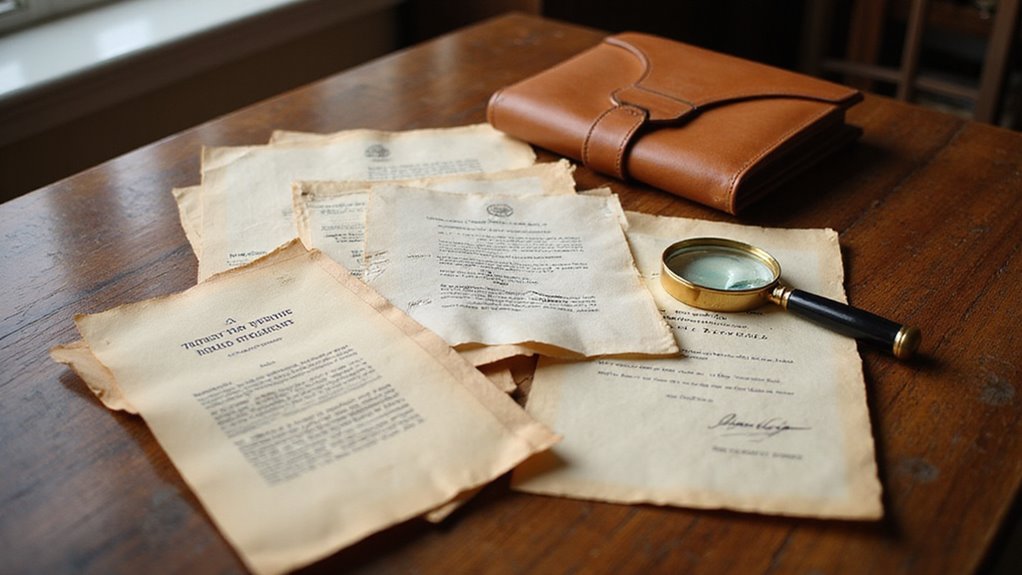Never underestimate the mountain of paperwork standing between inheritors and their ability to sell property legally. Dealing with inherited property sales can overwhelm even the most organized person, creating stress during an already difficult time. Fortunately, gathering the right documents early makes the entire process manageable and straightforward.
To sell inherited property, you need several key documents: a certified death certificate, the decedent’s will, Letters Testamentary or Letters of Administration, current property deed, and tax records. Additionally, Ohio law requires completing a Residential Property Disclosure Form and obtaining written consent from any co-heirs.
This blog will explore every document needed to successfully sell inherited property in Ohio.
Key Takeaways
- Certified death certificate proves inheritance and serves as the foundational document for probate filings and property transactions.
- Letters Testamentary or Letters of Administration confirm your legal authority to sell the inherited property.
- Current property deed shows ownership history and is essential for transferring title to new buyers.
- IRS Form 706 and Schedule D are required to report estate taxes and capital gains from the sale.
- Written consent from all co-heirs is mandatory before proceeding with any inherited property sale transaction.
What Documents Do You Need for Selling Inherited Property?

Essential documents for selling inherited property include six core items. A certified death certificate and the decedent’s will serve as primary proof of inheritance. Letters Testamentary or Letters of Administration from probate court establish legal authority to sell.
The current property deed shows ownership history and transfer details. A Residential Property Disclosure Form must be completed according to Ohio law 5302.30. Tax records with stepped-up basis calculations determine capital gains obligations. Moreover, these documents protect all parties involved in the sale. Proper documentation speeds up the closing process and prevents future legal issues.
How to Verify Your Inheritance Status?
You’ll need to establish legal proof of your inheritance before any sale transaction can proceed. Start by securing the death certificate, which serves as the foundational document for all probate filings in Ohio. Then gather either the deceased’s will for verification, Letters Testamentary/Administration from the probate court, or a notarized Affidavit of Heirship if you’re bypassing formal probate.
Death Certificate and Its Importance
A death certificate proves someone has passed away and allows legal actions after their death. This official document grants authority to handle the deceased person’s affairs and assets.
The certificate enables executors to access bank accounts, claim insurance, transfer property titles, and file tax returns. Most institutions require certified copies, not photocopies, for legal transactions.
Moreover, families need multiple copies to handle different matters simultaneously. Request at least 5 certified copies from the vital records office to avoid delays. The small investment in extra copies prevents holdups during the settlement process.
Last Will and Testament Verification
A valid will requires proper verification through an Ohio probate court before any property sale. Ohio Revised Code Chapter 2107 mandates filing the original will and death certificate for legal authentication. This court process confirms inheritance rights and ownership status.
Legal verification allows smooth transfer of the property title to new buyers. The probate court must authenticate your inheritance claim within the designated timeframe. Title companies need this verification to process the sale. A clear ownership chain protects everyone involved in the property transaction. Quick completion of this verification step helps avoid future legal complications.
Letters of Testamentary or Administration
Letters Testamentary and Administration prove your legal right to handle estate assets. Letters Testamentary show court approval when a will names you as executor. Letters of Administration grant authority if no will exists. These documents let you access accounts and transfer property.
Furthermore, title companies and financial institutions require certified copies from probate court. Each document must be an original or court-certified copy. Multiple copies speed up transactions with different organizations. Most importantly, these letters protect both executor and heirs during estate settlement. The court issues them quickly after reviewing proper documentation.
Affidavit of Heirship Explained
An Affidavit of Heirship legally establishes who inherits property when someone dies without a will. This document helps transfer assets to rightful heirs without lengthy probate court proceedings.
The affidavit requires specific details about the deceased person, including their date of death, marital status, and complete list of legal heirs. Most states mandate at least two witnesses unrelated to the family to verify these facts.
Furthermore, the completed affidavit must be filed with the county recorder’s office. Once recorded, this document creates a clear chain of title and allows heirs to sell, transfer, or manage inherited property.
What Legal Documents Prove Property Ownership?

Legal documents that prove property ownership include deeds, titles, and registration certificates. A deed serves as the primary legal document showing transfer of property ownership between parties. Property titles establish clear ownership rights and detail any existing liens or claims. Registration certificates from local government offices provide official records of ownership status.
Additional proof comes through tax records and mortgage documents. These supporting materials strengthen ownership claims. Most importantly, proper documentation protects property rights and simplifies future transfers. Furthermore, insurance policies and utility bills can provide supplementary evidence of ownership.
What Tax Forms Are Required When Selling Inherited Property?
You’ll need to determine which federal and state tax forms apply to your inherited property sale based on the estate’s value and timing. For federal purposes, estates exceeding the exemption threshold require IRS Form 706, while all sellers must report capital gains tax on Schedule D using the property’s stepped-up basis. You’re responsible for gathering documentation that proves the date-of-death valuation, as this establishes your cost basis and determines your actual taxable gain.
Estate Tax Return Requirements
Estate tax returns are mandatory for large inheritances based on specific thresholds. Federal estate tax returns must be filed when estates exceed $13.61 million in 2024. Ohio no longer requires state estate tax filings for deaths after 2013.
Essential documentation includes property appraisals and basis calculations. Executors need Form 706 for federal reporting and Schedule D for capital gains tracking. Accurate valuations protect heirs from future tax complications.
Previous Ohio tax forms apply only to inheritances from deaths before January 1, 2013. Professional assistance can ensure proper compliance with current requirements. As a result, proper documentation safeguards estate assets and prevents costly mistakes.
Capital Gains Tax Documentation
You must document the sale with IRS Schedule D to report capital gains tax. An official property appraisal establishes your stepped-up basis value at the date of inheritance. Federal basis rules apply in Ohio for inherited property calculations.
Essential records include the property appraisal, final closing statement, and improvement receipts. These documents protect your tax position and verify claims. Furthermore, proper documentation helps heirs maximize their inheritance benefits.
To ensure success, maintain a complete file of all property-related transactions. Additionally, accurate record-keeping prevents unnecessary tax exposure while meeting IRS requirements.
Step-Up Basis Verification Documents
Key documents to verify step-up basis calculations: Property owners must obtain a professional appraisal within 30 days of the owner’s death. The appraisal establishes an accurate fair market value baseline. County tax assessments from the year of death serve as supporting proof of value. Real estate agents can provide helpful market comparisons for additional verification.
Moreover, Form 706 estate tax returns contain official property valuations used by the IRS. These records protect taxpayers during future IRS reviews. Complete documentation helps heirs avoid costly tax disputes later.
How to Handle Property with Multiple Heirs?
When you’re selling inherited property with multiple heirs in Ohio, you’ll need written consent from every co-owner before proceeding with the transaction. If heirs disagree on the sale, you can execute buyout agreements to consolidate ownership, though unresolved disputes may require filing with probate court under Ohio Revised Code Section 2127.01. Court orders for property division become necessary when co-heirs can’t reach consensus, triggering a partition action that forces the sale and distributes proceeds according to each heir’s ownership stake.
Consent Documents from Co-Heirs
Required Consent Documents for Ohio Inherited Property Sales All co-heirs must provide written approval before any property sale can proceed. Ohio law requires complete documentation from every heir to protect buyer interests and ensure legal compliance.
The essential paperwork includes signed sale agreements and administrator certifications. Each heir needs to submit notarized consent forms that meet specific Ohio Revised Code standards. Probate courts also require filed buyout agreements when certain heirs maintain ownership. The Estate of Rinehart legal precedent confirms unanimous consent rules in Ohio courts. Smart sellers gather these documents early to prevent closing delays and protect all parties involved.
Buyout Agreements Between Heirs
Buyout agreements provide a legal path for heirs to transfer property ownership when selling isn’t unanimous. A formal buyout requires all heirs to sign a written agreement documenting the terms. One heir must purchase the ownership interests from others at fair market value according to a professional appraisal. The executor plays a key role in facilitating this process.
Moreover, all agreements must receive notarization and proper filing with the probate court. The county recorder’s office handles the final title transfer and deed execution. If disputes arise between heirs, Ohio law allows partition actions under Section 2127.01. As a practical step, heirs should consider legal counsel to ensure proper documentation and protect their interests throughout the buyout process.
Court Orders for Property Division
Legal partition through courts offers a clear solution when heirs cannot agree on property division. A formal petition must be filed under Ohio Revised Code Section 2127.01 to start the process. The court will review ownership documents and letters testamentary.
The judge can order either physical division or a complete property sale. A professional appraisal determines fair market value for all parties. Moreover, court supervision ensures proportional distribution of proceeds among beneficiaries. As a result, this legal approach prevents conflicts while protecting everyone’s financial interests. The court’s involvement guarantees a fair resolution for all heirs.
What Property Condition Disclosures Are Needed?
Property condition disclosures must include known defects, structural issues, and environmental hazards in Ohio. Ohio law requires a completed Residential Property Disclosure Form before any property sale closes. This form protects both buyers and sellers from future disputes. A professional property inspection helps identify important defects that need disclosure.
The law applies to 82% of inherited property sales, even those marketed “as-is.” Proper documentation ensures transparency and builds trust with potential buyers. Furthermore, title companies verify all disclosure requirements before finalizing any transaction.
| Disclosure Element | Your Responsibility |
|---|---|
| Known defects | Full written disclosure required |
| Structural issues | Must be documented honestly |
| Environmental hazards | Legal obligation to inform buyers |
How to Expedite the Document Gathering Process?

You’ll accelerate your sale by organizing required documents systematically before listing the inherited property. Create a comprehensive checklist covering probate court filings, title documents, tax forms, and heir consents to prevent delays at closing. Partner with experienced title companies or digital documentation platforms that specialize in estate transactions—they’ll identify missing documents early and streamline the entire process.
Creating a Document Checklist
Essential documents must be organized systematically for property transactions. Legal heirs require death certificates, property deeds, and tax records within 30 days of passing. A complete set of certified documents prevents future disputes or legal complications.
Courts demand original documents with official seals, not photocopies. The title company needs these papers to verify ownership claims. Electronic copies help share documents quickly with all involved parties. Each state follows different probate rules for document requirements. Professional assistance from attorneys ensures proper documentation.
Working with Professional Title Companies
Title companies streamline real estate transactions through professional title search services. These firms access county records directly and complete title searches in 2-3 business days. Your real estate attorney will work with them to meet legal requirements.
Professional title companies follow strict protocols under Ohio Revised Code Chapter 5301. Their document checklists prevent problems with missing paperwork or incomplete heir documentation. As a result, beneficiaries receive faster service. Title insurance protects buyers from future ownership claims or disputes. Experienced staff members handle complex inheritance situations with expertise and accuracy.
Using Digital Documentation Services
Digital documentation services speed up paperwork by gathering records online from multiple sources. These platforms fetch documents from Ohio courts and offices within 24-48 hours. A secure portal provides easy access to death certificates, property deeds, and tax records.
The process becomes simpler through automated features. Built-in compliance tools create legal heir documents that meet Ohio standards. Quick document retrieval happens across several counties at once.
Real-time updates keep everyone informed about pending requests. Moreover, digital signatures meet state requirements for legal validation. These tools help heirs settle estates faster and more efficiently.
Conclusion
At Shawn Buys Houses, we understand the challenges of selling inherited property with complex documentation requirements. We regularly work with estates throughout Oklahoma City and surrounding areas. Our team simplifies the selling process by handling all paperwork complications.
When heirs need to sell quickly, we offer a straightforward solution without requiring extensive documentation or disclosure forms. We purchase properties directly from estates in Oklahoma with minimal paperwork requirements. Our cash offers allow sellers to avoid the traditional market’s lengthy processes.
We serve all major cities across Oklahoma State with our hassle-free home buying services. Our team can close transactions within days instead of months, providing immediate cash solutions. We handle properties that need repairs or have title complications, making the inheritance sale process easier for families.


